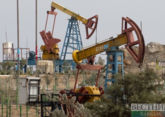Kazakhstan's economy, Central Asia's largest, witnessed an overall economic growth of 4.2 per cent on-year through the first half of the current year, according to the country's national statistics agency. In the first quarter of the year, growth stood at 3.6 per cent, and in the first half of 2016 at only 0.1 per cent. As Stratfor writes in an article "Kazakhstan: Forecast and Realities in Economic Development", the Asian Development Bank, which puts economic growth for Kazakhstan for this year at 2.6 per cent and for next year at 2.9 per cent, spoke of "an unexpected economic upswing in the first quarter of 2017" in a comment. The International Monetary Fund insists on a GDP increase of 2.5 per cent, along with 6 per cent for Uzbekistan and 6.5 per cent for Turkmenistan. And the European Bank for Reconstruction and Development (EBRD) finds itself at the bottom with a forecast of only 2.4 per cent for the current year.
Virtually none of those institutions comes up with a proper breakdown or a segment comparison. Local assessments tend to give more clarity. "According to preliminary data, the economic growth in the first half of this year reached 4.2% year-on-year, after 3.6% in the first quarter. In our assessment, the economic growth in the second quarter alone, amounted to 4.8%, which is the best figure since 2015, the seasonally adjusted number came at 1.7% quarter-on-quarter, based on our estimates," in the words of a recent analysis by Halyk Finance, the investment service branch of Kazakhstan's Halyk Bank.
The secret remains oil
The report does not deny that growth or no growth, Kazakhstan's reliance on external commodity sales keeps setting the scene. According to a recent report by Reuters referring to the national statistics agency, Kazakhstan produced 35.863 million tonnes of crude oil in the first half of 2017, together with 6.691 million tonnes of gas condensate – meaning on-year increases of 8.7 and 15.6 per cent, respectively. Moreover, Kazakhstan's benchmark Urals topped $50 almost throughout the period and settled at $52.09 on August 4. According to OPEC's latest report, the blend's average price over the first six months stood at $50.41 per barrel, up from $38.25 a year earlier.
The persistent dependence on oil sales weighs heavily on trends in industrial output and in capital investment patterns. While the industrial output figure looks promising, the overall investment figure indicates a worrying lack of financial resources in Kazakhstan's various economic sectors – all the more painful for it since the bulk of the investments go to subsoil sectors and indirectly hurt other sectors such as agriculture, construction and manufacturing.
'A matrix of indicators'

In order to determine how to turn the tide, a clearer picture of existing trends is necessary, authorities tend to admit. According to Kazakhstan's Minister of Economy Timur Suleimenov as quoted recently by the Astana Times the government intends to base future economic policies on "a more comprehensive assessment of factors contributing to the country's overall economic performance". "We are currently developing a strategic plan for 2020-2025. This document will contain not only some aspects about economic development but also about the ecological and social aspects. We plan to develop a matrix of indicators, ranging from life expectancy, infant mortality, GDP, on the basis of which the overall progress of the state will be monitored. […]."
Population stratification by income
The minister's words can be seen as an echo of a long series of statements by Kazakh President Nursultan Nazarbayev on the issue. The head of state once more suggested "revising the methodology to calculate the GDP per capita as the traditional GDP creates a false perception of economic prosperity", at the plenary session of the 10th Astana Economic Forum in June: "The GDP indicator has a number of significant flaws. It does not reflect the long-term nature of economic activity and does not show the citizens' well-being and it does not take into account population stratification by income."

Revision of assessment required
The "revision" suggested here might well necessitate a thorough modification of economic targets. For instance, should a target of 7 per cent on-year for a certain period of time be set, it would have to include improvements of purchasing power for various income groups of the population varying from 1 per cent for the top layer to 15 per cent for the bottom layer. Only in this way a domestic consumer market can be created that will sustain a substantial expansion of productivity. So far, attempts to attract investment have not been accompanied by such a prospect – hence the limited response to such attempts by investors.










